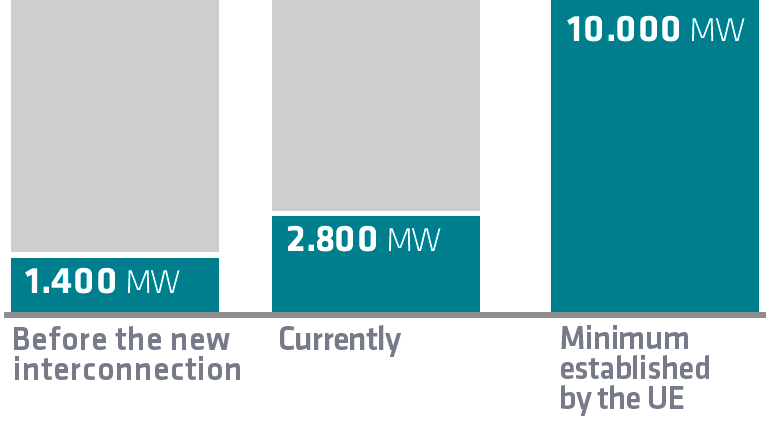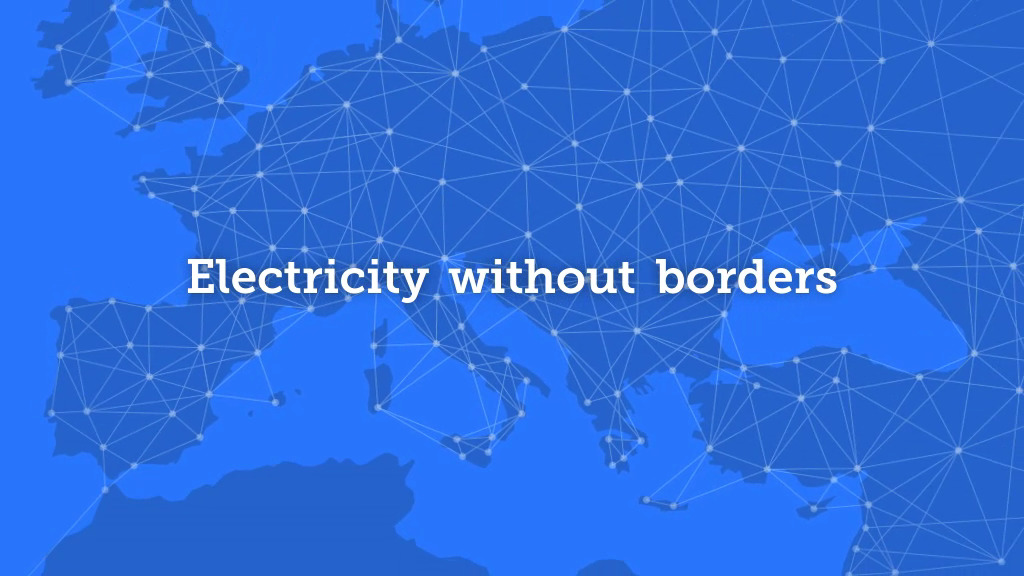We are a global operator of essential infrastructure
The Spain-France underground electrical interconnection: a world-wide pioneering project.
Red Eléctrica de España (REE) and Réseau de Transport d'Electricité (RTE) signed in 2008 an agreement to create the company Inelfe, a mixed-capital corporation, jointly-owned in equal shares, with the aim of constructing the new electrical interconnection line that would link Spain and France through the Eastern Pyrenees. An infrastructure that will double the commercial exchange capacity with France from 1400 to 2800 megawatts (MW), and that will increase the security, stability and quality of power supply of both countries.
The interconnection, declared a project of European interest, will additionally improve the quality of power supply to the towns in the Roussillon and Empordà regions, guarantee the electrical power supply necessary for the correct operation of the high-speed train on the Spanish side, and allow the integration of a greater volume of renewable energy into the grid, especially wind energy from the Iberian system.
The new interconnection line, which has a length of 64.5 kilometres, links the towns of Santa Llogaia, near Figueres (Spain), with Baixas, near Perpignan (France). The interconnection link is completely underground and has been housed in a concrete trench, except for the stretch that crosses the Pyrenees that runs through an 8.5 kilometre tunnel that runs parallel to the high-speed railway line.
The overall investment totals 700 million euros. The project received a financial grant of 225 million euros under the framework of the European Energy Programme for Recovery (EEPR). Additionally, it received funding from the European Investment Bank through a loan of 350 million euros granted to REE and RTE.
The construction works for the interconnection line concluded in February 2015, coinciding with the official inauguration of the same. Since then, the line has been in operation but in technical testing mode. The new electrical interconnection began its commercial operation on 5 October, 2015.
For Red Eléctrica, it has been a complex and exceptional infrastructure that represents one of the greatest challenges faced by the company in recent years and will be the first interconnection with France that is brought into service in almost 30 years.
The new electrical interconnection between Spain and France is a project declared to be of European interest. Spain currently has an interconnection exchange capacity level with Europe far from the minimum set by the European Union (EU) for 2020; established at no less than 10% of installed generation capacity. The EU established this minimum in 2002 to eliminate isolated electricity systems, facilitate mutual support and promote the single European energy market.
This new line is essential because it will duplicate the commercial exchange capacity from 1400 to 2800 MW; but even now, if you consider that the real support to the electricity system can come only from Central Europe through the border with France, which will enable an interconnection ratio of 2.8%, Spain will still need to develop new interconnections. Even with the rest of interconnections planned until 2020, Spain will be the only country in continental Europe below the minimum set by the European Union.

The company Inelfe is a mixed-capital corporation, legally established on 1 October 2008, jointly-owned in equal shares by Spain’s and France’s electrical transmission grid management companies, REE (Red Eléctrica de España) and RTE (Réseau Transport d’Électricité) respectively.
Inelfe is a simplified joint-stock company governed by French law.
- It is a 320 kV direct current line. Due to its technical characteristics (underground line and length of 64.5 km) and in order to reduce power losses during the underground transmission, the interconnection will work with direct current instead of alternating current, used in the Spanish and French transmission grids. This implies the need for converter stations at each end of the line.
- With a total length of 64.5 kilometres, the entire interconnection link is completely underground and has been housed in a concrete trench, except for the stretch that crosses the Pyrenees and that runs through an 8.5 kilometre tunnel.
-
The tunnel, that runs parallel to the high-speed railway line, is 8.5 kilometres in length and 3.5 metres in diameter and houses the cables in the stretch of line that crosses through the Pyrenees. Of the 8.5 kilometres, 7.5 kilometres run through French territory and 1 kilometre in Spanish territory. This tunnel and the high-speed train tunnel both have their entrance and exit in the municipalities of La Jonquera (Spain) and Montesquieu des Albères (France).
To construct the tunnel, two tunnel boring machines were used, both designed and manufactured especially for this project: ‘Alberes’ on the Spanish side and ‘Canigó’ on the French side. The tunnel boring machines began the drilling work in February 2012 and October 2012 respectively, and completed the task in April 2013.
- Two converter stations have been built, one at each end of the interconnection route: Santa Llogaia (Spain) and Baixas (France). These will be used to convert alternating current to direct current and vice versa. Each station has more than 5,400 power modules for the conversion process.
- This is the first time in Europe that Voltage Source Converter (VSC) technology has been used in an electrical interconnection link of this power capacity, a technology with the capability to quickly convert alternating current to direct current. The advantage of direct current is that it allows underground connections that run over long distances, such as this one with a length of 64.5 kilometres.
27 June 2008: the governments of Spain and France sign the agreement in Zaragoza for the electrical interconnection between the two countries.
1 October 2008: the Spanish company Red Eléctrica de España (REE) and the French company Réseau de Transport d'Electricité (RTE) create the company called Inelfe, a mixed-capital corporation, jointly-owned in equal shares, to construct the electrical interconnection.
13 December 2010: REE obtains the environmental impact statement for the project.
16 December 2010: Inelfe awards the construction of the electrical interconnection to Siemens and Prysmian.
1 February 2011: Inelfe awards the construction of the tunnel for the electrical interconnection to the consortium led by Eiffage TP and Dragados.
6 October 2011: the European Investment Bank signs a loan of 350 million euros with Inelfe, REE and RTE to finance the construction of the interconnection.
14 February 2012: tunnel drilling commences on the Spanish side.
17 October 2012: tunnel drilling commences on the French side.
22 April 2013: tunnel boring works for the electrical interconnection completed.
January 2014: the installation of the cables completed in the trench in the French section of the route.
February 2014: installation of cables in the trench system starts on the Spanish side.
August 2014: cable installation work commences in the interconnection tunnel.
February 2015: conclusion of civil works for the interconnection and commencement of the technical testing phase.
5 October 2015: began its commercial operation.
The project included the adoption of a series of preventive and corrective measures so as to minimise the impact on the natural and social environment along its route:
- In addition to backing the installation of a fully-underground line, the route was kept as far as possible from towns and areas of higher population density, as well as natural spaces. Therefore, the interconnection, whenever possible, takes advantage of existing infrastructure corridors such as the AP-7 motorway and high-speed train.
- In order to reduce the visual and environmental impact, the line passes under motorways and railroads through a system of micro- tunnels, the same system that is used to cross beneath rivers with the aim of reducing the impact on river flows and water levels.
- The existing roads and paths were used during the construction works, and once the works concluded, these were restored
- In both countries, monitoring committees were created to control and verify that all the established environmental nature measures were met.
- Inelfe created direct and indirect job positions in the Roussillon and Empordà regions during the entire period the works were being executed.
- Inelfe has collaborated in the main cultural and sporting events. This has resulted in a direct and ongoing collaboration with the ‘Pau Casals’ Music Festival in Prada, The Peralada Festival, the Figueres Acoustic Festival, the ‘Temporada Alta’ Festival in Girona, the Archipel theatre in Perpignan or the school of the USAP rugby club.

















